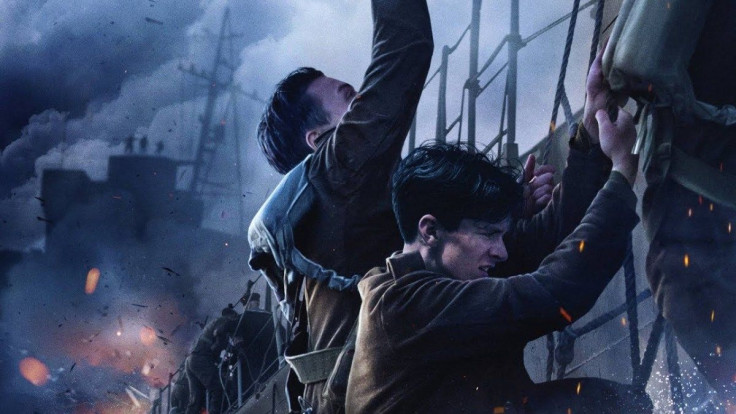To hear stories of Christopher Nolan on the set of his movies — always well-dressed, precise and constantly sipping tea — suggests what the director’s like at rest, evoking the anachronistic specter of an English gentleman reading poetry in a parlor, perhaps on one side of a chessboard. But Dunkirk had me thinking he games. Hard. Like, all night on Overwatch, or more likely, Battlefield 1. Their influence, and that of multiplayer shooters in particular, are all over Dunkirk.
There are the stylistic touches, like the proliferation of first-person shots that place the viewer behind the reflector gunsight of a British Spitfire dogfighting Luftwaffe. Or the insistent tick-tick-tick of the Hans Zimmer soundtrack, which replaces an orchestral, emotional subtext with a thumping, clock-world deadline: the objective must be achieved in so many minutes. Dunkirk even opens on a Roadie Run of sorts, as Tommy (Fionn Whitehead) sprints from German machine-gun fire.
But there’s not really much in the way of one-to-one correspondence. Nolan isn’t like the new generation of game-conscious directors like Jordan Vogt-Roberts, who will follow Kong: Skull Island with his adaptation of Metal Gear Solid. And Nolan, with his film fetishism and practical effects fixation (Dunkirk features stunning aerial photography of real Spitfires), will be the very last to embrace the production techniques Andy Serkis described to The Guardian: "There was probably a time when people in the games industry wanted to emulate films, but now it's very much the other way around: the technology is driven by video games. So, for instance, virtual production, pre-vis, many of the tools we use in the film industry have come out of the games industry."
Rather than a conscious adaptation of first-person shooters, like Tom Cruise’s infinite respawns in Edge of Tomorrow, Nolan has adopted something larger from games: the central experiential conceit.
Before Dunkirk, the greatest war movies juxtaposed the immensity of war with a deep personalization of protagonist combatants. War movies like Come and See, Paths of Glory, Full Metal Jacket and All Quiet on the Western Front track individuals or groups through war, tying viewer experience to theirs and depending upon a rich empathic connection to convey the trauma, pain, terror and grief they experience. The war movie genre is often deeply personal, even psychological. Movies like Apocalypse Now, Lawrence of Arabia, The Life and Death of Colonel Blimp, Patton and The Bridge on the River Kwai become character studies, twisting their central figures under the weight of mass death and suffering. Efforts at birds-eye view depictions of war, like A Bridge Too Far or Pearl Harbor, are often less successful, as their immense ensemble casts and impersonal scale blunt anything visceral, flattening experience back into dull fact.
Dunkirk is very different. I’m not sure that there’s anything like it (and there’s nothing approaching it in Nolan’s previous movies). Dunkirk takes the viewers’ engagement with the subject soldier entirely for granted. We follow Tommy over the course of a week, but learn nearly nothing personal about him. We know the fighter pilot Farrier (Tom Hardy) to be competent and willing to risk his safety, but that’s about it.
Though it does follow characters, Dunkirk isn’t a character narrative, but an experiential one. Tommy, Farrier and Peter are very nearly generic avatars — containers through which we live out the terror of a torpedo attack, the pressure of air combat and the tension of imminent violence. Its perspective hopping from ship to plane to infantry, Dunkirk feels like a narrative that expands to fill the combat space with a multiplicity of narrow, intimate moments, like 106 minutes observing players on a Battlefield map. Contrary to the standards of most mass-audience movie stories, Dunkirk understands experience as narrative in and of itself.
“I think the visual nature of the storytelling is something I’m excited about. It’s something I value in films and film history; I’m an incredible lover of silent films,” Nolan told Fandango. “The challenge of taking on what I call a present-tense narrative – that is to say, we don’t learn a lot about the people we’re experiencing this with. We really just try to live in the moment and experience it with them, and look through their eyes.”
Sure, maybe Nolan did see himself as taking primary inspiration from silent films, but the confidence with which Dunkirk accomplishes its multiple perspective “present-tense narrative” suggests another antecedent. Combat video games provided thousands of hours of experiential proof-of-concept, culturally validating Nolan’s cinematic experiment and proving in advance the power of minimally-mediated immediacy.
To be clear, there are far more ways Dunkirk is not like video games than is, and hundreds of movies that wear their video game influence more openly. But what we may be seeing in Dunkirk is one art form soaking into another. What’s most powerfully game-y about Dunkirk is not any stylistic nod or special effects wizardry, but the diminishment of narrative in the face of experience.
In 1926, the year after the publication of her novel Mrs. Dalloway, Virginia Woolf wrote “The Cinema,” an essay heralding movies as an art form capable of revealing human truths through direct and emotional representation, unencumbered by the built-up social and artistic limitations of philosophy and literature.
“People say that the savage no longer exists in us, that we are at the fag-end of civilization, that everything has been said already, and that it is too late to be ambitious. But these philosophers have presumably forgotten the movies,” Woolf writes. “We see life as it is when we have no part in it. As we gaze we seem to be removed from the pettiness of actual existence… from this point of vantage, as we watch the antics of our kind, we have time to feel pity and amusement, to generalize, to endow one man with the attributes of the race.”
As Woolf composed these words, literary modernism was in full bloom. James Joyce’s Ulysses was released in 1922, as was T.S. Eliot’s The Wasteland. In that decade America found its own Modernist champions as well, including William Faulkner, Langston Hughes, F. Scott Fitzgerald and Zora Neale Hurston. Literature would never be the same, as authors delved into psychology, played with freer forms and embraced the fragmented subjectivity of lived experience.
And while literary modernism had a number of precursors — including Freudian and Jungian psychology, Nietzschean philosophy and non-representational or Impressionist painters — Woolf captures in “The Cinema” the symbiotic relationship between literature and movies, one an art form undergoing a titanic transformation, the other just in its infancy.
That interplay formed a virtuous feedback loop, film feeding literature and literature feeding film. Often this went far beyond nebulous effects. Faulkner, whose novel The Sound and the Fury captured the fragmentation of the individual shot and the relational power of montage, wrote screenplays on contract (including The Big Sleep). As Laura Marcus writes for the British Library, describing such events as Joyce’s investment in a movie theater and subsequent meeting with Soviet director Sergei Eisenstein (Battleship Potemkin, Alexander Nevsky), “It seems certain that Joyce was drawing upon such cinematic effects for his own animations of the object world in Ulysses.”
While a similar feedback loop has long been observable between video games and movies, Dunkirk feels like a step beyond the conscious pillaging or gimmickry that usually defines the relationship. Instead, Dunkirk feels like a movie that has, consciously or unconsciously, absorbed the deeper lessons of a different medium, intuiting how narrative technique has been expanded outside of the movie theater. Could this be indicative of a change in film? Perhaps video games, an art form in its infancy, can crack apart movies like movies cracked apart novels.
The actual evidence for Nolan being a bona-fide COD bro is thin. His brother and frequent collaborator Jonathan Nolan is into Mass Effect and Portal 2. Nolan has definitely played some Halo, at least. And might still be thinking on his proposed Inception video game. But how often Nolan sits down with a DualShock doesn’t really matter. Dunkirk tells a war story in a harrowing new way that would have been hard to imagine in a previous era.



















